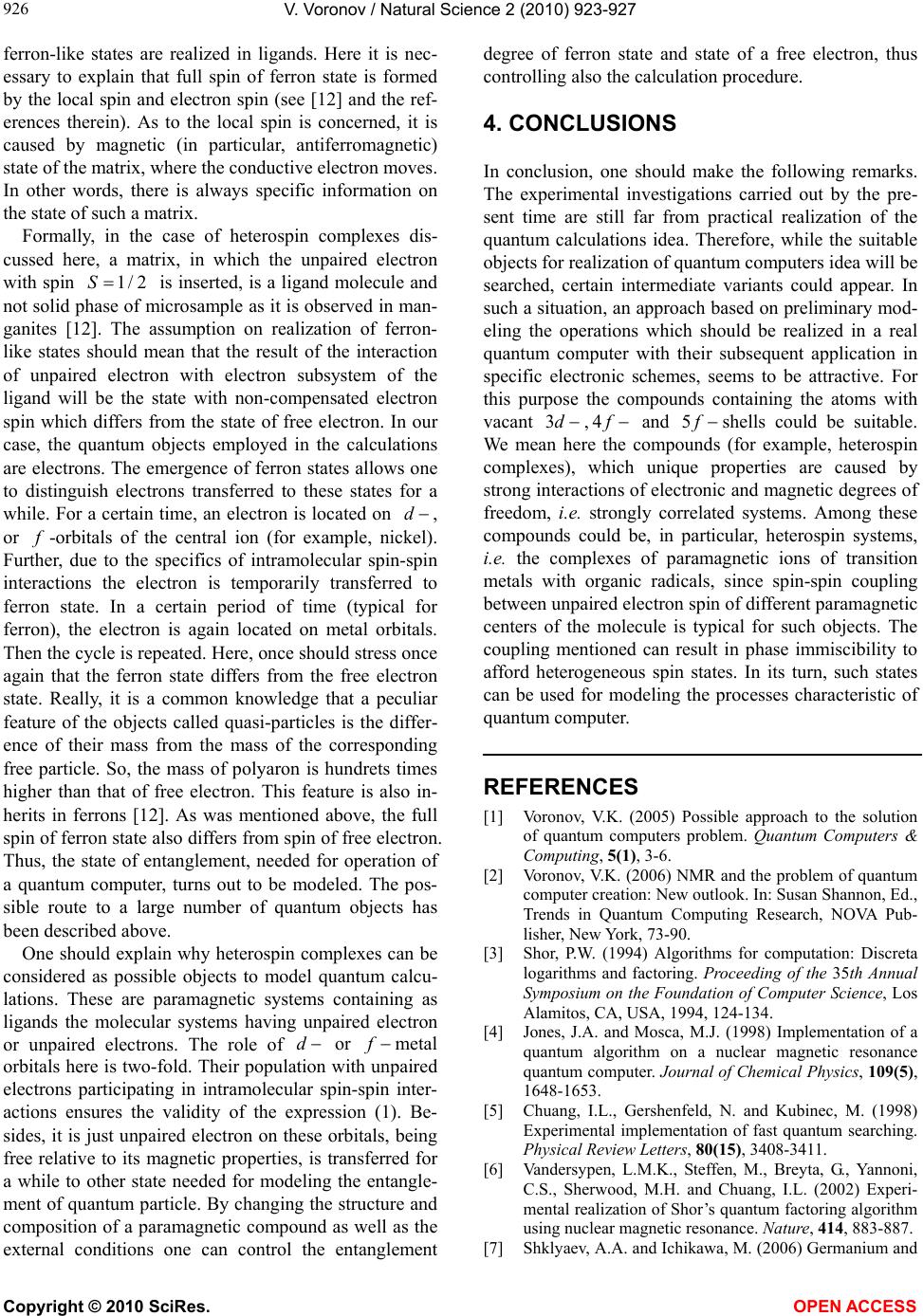
V. Voronov / Natural Science 2 (2010) 923-927
Copyright © 2010 SciRes. OPEN ACCESS
926
ferron-like states are realized in ligands. Here it is nec-
essary to explain that full spin of ferron state is formed
by the local spin and electron spin (see [12] and the ref-
erences therein). As to the local spin is concerned, it is
caused by magnetic (in particular, antiferromagnetic)
state of the matrix, where the conductive electron moves.
In other words, there is always specific information on
the state of such a matrix.
Formally, in the case of heterospin complexes dis-
cussed here, a matrix, in which the unpaired electron
with spin 1/2S is inserted, is a ligand molecule and
not solid phase of microsample as it is observed in man-
ganites [12]. The assumption on realization of ferron-
like states should mean that the result of the interaction
of unpaired electron with electron subsystem of the
ligand will be the state with non-compensated electron
spin which differs from the state of free electron. In our
case, the quantum objects employed in the calculations
are electrons. The emergence of ferron states allows one
to distinguish electrons transferred to these states for a
while. For a certain time, an electron is located on d
,
or
-orbitals of the central ion (for example, nickel).
Further, due to the specifics of intramolecular spin-spin
interactions the electron is temporarily transferred to
ferron state. In a certain period of time (typical for
ferron), the electron is again located on metal orbitals.
Then the cycle is repeated. Here, once should stress once
again that the ferron state differs from the free electron
state. Really, it is a common knowledge that a peculiar
feature of the objects called quasi-particles is the differ-
ence of their mass from the mass of the corresponding
free particle. So, the mass of polyaron is hundrets times
higher than that of free electron. This feature is also in-
herits in ferrons [12]. As was mentioned above, the full
spin of ferron state also differs from spin of free electron.
Thus, the state of entanglement, needed for operation of
a quantum computer, turns out to be modeled. The pos-
sible route to a large number of quantum objects has
been described above.
One should explain why heterospin complexes can be
considered as possible objects to model quantum calcu-
lations. These are paramagnetic systems containing as
ligands the molecular systems having unpaired electron
or unpaired electrons. The role of d or
metal
orbitals here is two-fold. Their population with unpaired
electrons participating in intramolecular spin-spin inter-
actions ensures the validity of the expression (1). Be-
sides, it is just unpaired electron on these orbitals, being
free relative to its magnetic properties, is transferred for
a while to other state needed for modeling the entangle-
ment of quantum particle. By changing the structure and
composition of a paramagnetic compound as well as the
external conditions one can control the entanglement
degree of ferron state and state of a free electron, thus
controlling also the calculation procedure.
4. CONCLUSIONS
In conclusion, one should make the following remarks.
The experimental investigations carried out by the pre-
sent time are still far from practical realization of the
quantum calculations idea. Therefore, while the suitable
objects for realization of quantum computers idea will be
searched, certain intermediate variants could appear. In
such a situation, an approach based on preliminary mod-
eling the operations which should be realized in a real
quantum computer with their subsequent application in
specific electronic schemes, seems to be attractive. For
this purpose the compounds containing the atoms with
vacant 3d
,4
and 5
shells could be suitable.
We mean here the compounds (for example, heterospin
complexes), which unique properties are caused by
strong interactions of electronic and magnetic degrees of
freedom, i.e. strongly correlated systems. Among these
compounds could be, in particular, heterospin systems,
i.e. the complexes of paramagnetic ions of transition
metals with organic radicals, since spin-spin coupling
between unpaired electron spin of different paramagnetic
centers of the molecule is typical for such objects. The
coupling mentioned can result in phase immiscibility to
afford heterogeneous spin states. In its turn, such states
can be used for modeling the processes characteristic of
quantum computer.
REFERENCES
[1] Voronov, V.K. (2005) Possible approach to the solution
of quantum computers problem. Quantum Computers &
Computing, 5(1), 3-6.
[2] Voronov, V.K. (2006) NMR and the problem of quantum
computer creation: New outlook. In: Susan Shannon, Ed.,
Trends in Quantum Computing Research, NOVA Pub-
lisher, New York, 73-90.
[3] Shor, P.W. (1994) Algorithms for computation: Discreta
logarithms and factoring. Proceeding of the 35th Annual
Symposium on the Foundation of Computer Science, Los
Alamitos, CA, USA, 1994, 124-134.
[4] Jones, J.A. and Mosca, M.J. (1998) Implementation of a
quantum algorithm on a nuclear magnetic resonance
quantum computer. Journal of Chemical Physics, 109(5),
1648-1653.
[5] Chuang, I.L., Gershenfeld, N. and Kubinec, M. (1998)
Experimental implementation of fast quantum searching.
Physical Review Letters, 80(15), 3408-3411.
[6] Vandersypen, L.M.K., Steffen, M., Breyta, G., Yannoni,
C.S., Sherwood, M.H. and Chuang, I.L. (2002) Experi-
mental realization of Shor’s quantum factoring algorithm
using nuclear magnetic resonance. Nature, 414, 883-887.
[7] Shklyaev, A.A. and Ichikawa, M. (2006) Germanium and